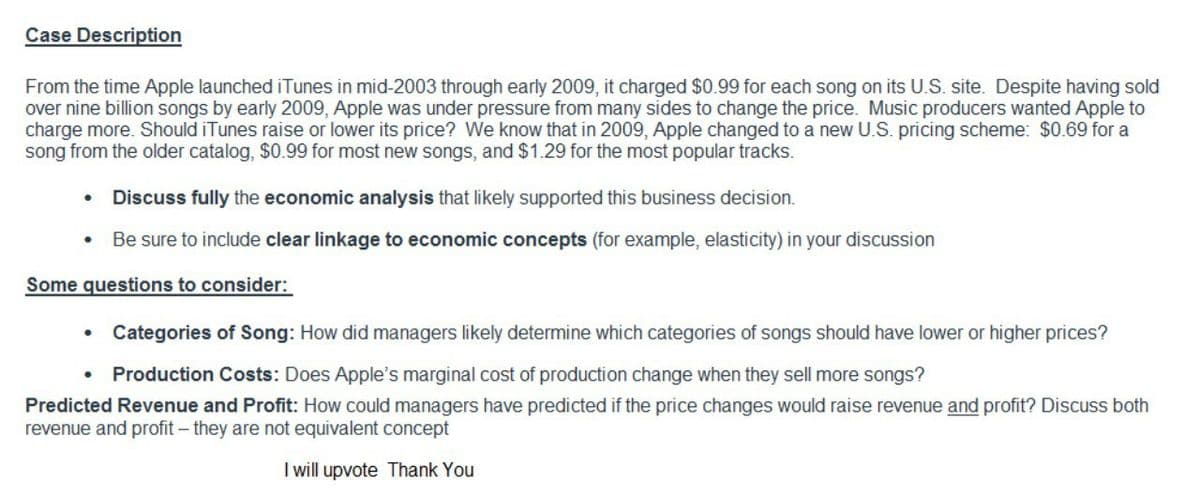Case Description From the time Apple launched iTunes in mid-2003 through early 2009, it charged $0.99 for each song on its U.S. site. Despite having so over nine billion songs by early 2009, Apple was under pressure from many sides to change the price. Music producers wanted Apple to charge more. Should iTunes raise or lower its price? We know that in 2009, Apple changed to a new U.S. pricing scheme: $0.69 for a song from the older catalog, $0.99 for most new songs, and $1.29 for the most popular tracks. Discuss fully the economic analysis that likely supported this business decision. • Be sure to include clear linkage to economic concepts (for example, elasticity) in your discussion Some questions to consider: Categories of Song: How did managers likely determine which categories of songs should have lower or higher prices? Production Costs: Does Apple's marginal cost of production change when they sell more songs? Predicted Revenue and Profit: How could managers have predicted if the price changes would raise revenue and profit? Discuss both revenue and profit – they are not equivalent concept Luillupuete Thepk You
Case Description From the time Apple launched iTunes in mid-2003 through early 2009, it charged $0.99 for each song on its U.S. site. Despite having so over nine billion songs by early 2009, Apple was under pressure from many sides to change the price. Music producers wanted Apple to charge more. Should iTunes raise or lower its price? We know that in 2009, Apple changed to a new U.S. pricing scheme: $0.69 for a song from the older catalog, $0.99 for most new songs, and $1.29 for the most popular tracks. Discuss fully the economic analysis that likely supported this business decision. • Be sure to include clear linkage to economic concepts (for example, elasticity) in your discussion Some questions to consider: Categories of Song: How did managers likely determine which categories of songs should have lower or higher prices? Production Costs: Does Apple's marginal cost of production change when they sell more songs? Predicted Revenue and Profit: How could managers have predicted if the price changes would raise revenue and profit? Discuss both revenue and profit – they are not equivalent concept Luillupuete Thepk You
Managerial Economics: Applications, Strategies and Tactics (MindTap Course List)
14th Edition
ISBN:9781305506381
Author:James R. McGuigan, R. Charles Moyer, Frederick H.deB. Harris
Publisher:James R. McGuigan, R. Charles Moyer, Frederick H.deB. Harris
Chapter10: Prices, Output, And Strategy: Pure And Monopolistic Competition
Section: Chapter Questions
Problem 2.2CE
Related questions
Question
I need the answer as soon as possible

Transcribed Image Text:Case Description
From the time Apple launched iTunes in mid-2003 through early 2009, it charged $0.99 for each song on its U.S. site. Despite having sold
over nine billion songs by early 2009, Apple was under pressure from many sides to change the price. Music producers wanted Apple to
charge more. Should iTunes raise or lower its price? We know that in 2009, Apple changed to a new U.S. pricing scheme: $0.69 for a
song from the older catalog, $0.99 for most new songs, and $1.29 for the most popular tracks.
Discuss fully the economic analysis that likely supported this business decision.
• Be sure to include clear linkage to economic concepts (for example, elasticity) in your discussion
Some questions to consider:
• Categories of Song: How did managers likely determine which categories of songs should have lower or higher prices?
Production Costs: Does Apple's marginal cost of production change when they sell more songs?
Predicted Revenue and Profit: How could managers have predicted if the price changes would raise revenue and profit? Discuss both
revenue and profit – they are not equivalent concept
I will upvote Thank You
Expert Solution
This question has been solved!
Explore an expertly crafted, step-by-step solution for a thorough understanding of key concepts.
This is a popular solution!
Trending now
This is a popular solution!
Step by step
Solved in 2 steps

Recommended textbooks for you

Managerial Economics: Applications, Strategies an…
Economics
ISBN:
9781305506381
Author:
James R. McGuigan, R. Charles Moyer, Frederick H.deB. Harris
Publisher:
Cengage Learning

Exploring Economics
Economics
ISBN:
9781544336329
Author:
Robert L. Sexton
Publisher:
SAGE Publications, Inc

Principles of Economics 2e
Economics
ISBN:
9781947172364
Author:
Steven A. Greenlaw; David Shapiro
Publisher:
OpenStax

Managerial Economics: Applications, Strategies an…
Economics
ISBN:
9781305506381
Author:
James R. McGuigan, R. Charles Moyer, Frederick H.deB. Harris
Publisher:
Cengage Learning

Exploring Economics
Economics
ISBN:
9781544336329
Author:
Robert L. Sexton
Publisher:
SAGE Publications, Inc

Principles of Economics 2e
Economics
ISBN:
9781947172364
Author:
Steven A. Greenlaw; David Shapiro
Publisher:
OpenStax
